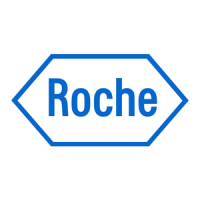Roche Diagnostics
A-26 Operator’s Manual · Version 3.1
2 Introduction to the instrument Cedex Bio System
Daily operation
Calibration
Calibration is the process that establishes, under specified conditions, the
relationship between values indicated by the analytical instrument and the
corresponding known values of an analyte.
Periodic calibration is required because the concentration of reagents can change
over time.
Reagents are typically calibrated with a two-point calibration, measuring the
predefined value of a multicalibrator and of system water. Some reagents are
calibrated using a set of calibrators.
On the Cedex Bio instrument, reagents are handled as sets of up to three reagents.
(You always load and unload all reagents of a set.) As a consequence, all reagents
(bottles) of a set are calibrated when performing calibration.
The system checks when calibration is due.
When a calibration is due depends mainly on two definitions, the calibration type
and the calibration sequence.
Calibration type
The calibration types Set and Lot define the manner in which the system determines
whether there is a valid calibration result for a particular reagent set.
Set calibration Set calibration results are valid for the calibrated set only. They can be generated from
any reagent set.
Lot calibration Lot calibration results are valid for the reagent set they were calibrated with and for
all subsequent reagent sets of the same lot. Usually, lot calibrations are generated by
calibrating the first reagent set of a new lot. There can only be one accepted lot
calibration result for the reagents of a given lot.
Let us suppose that you place the first reagent set of a new lot and calibrate it straight
away. Let us further assume that subsequent control measurements suggest that a
new calibration is required. Within the first 24 hours of placing a set on the system,
you can recalibrate it, and possibly existing lot calibration results of this set are
superseded. When this period has elapsed you can no longer change the lot
calibration results. (To generate new lot calibration results, you would have to delete
the existing results and then calibrate a new reagent set.)
The following table illustrates the two calibration types in an example.
Assumptions:
o Sequence: Each Lot and Interval.
o Interval: 5 days.
(Note that the interval (re)starts when a set is calibrated as a result of the interval
expiring or a new lot being started.)
Each reagent set must have accepted calibration results to be available for use in tests.
Lot calibration is relevant if you work with the calibration sequence [Each Lot and Interval].

